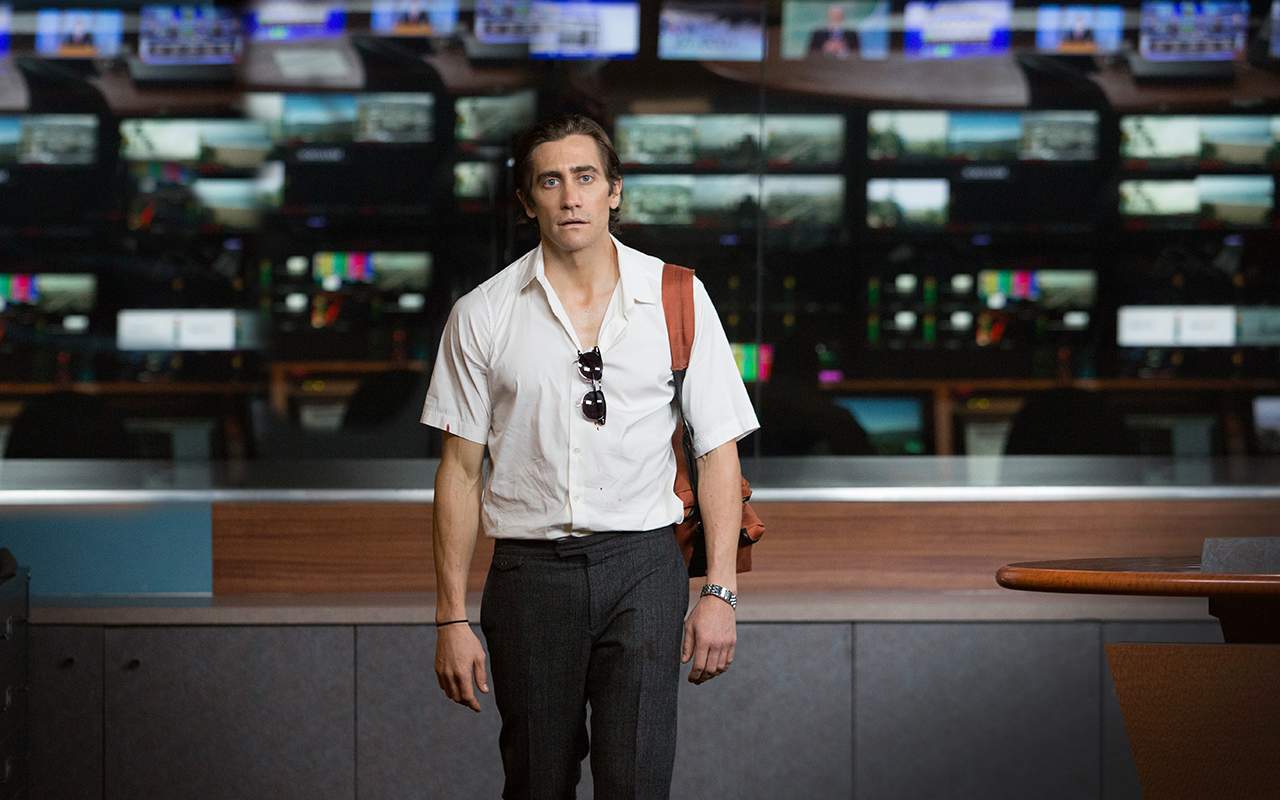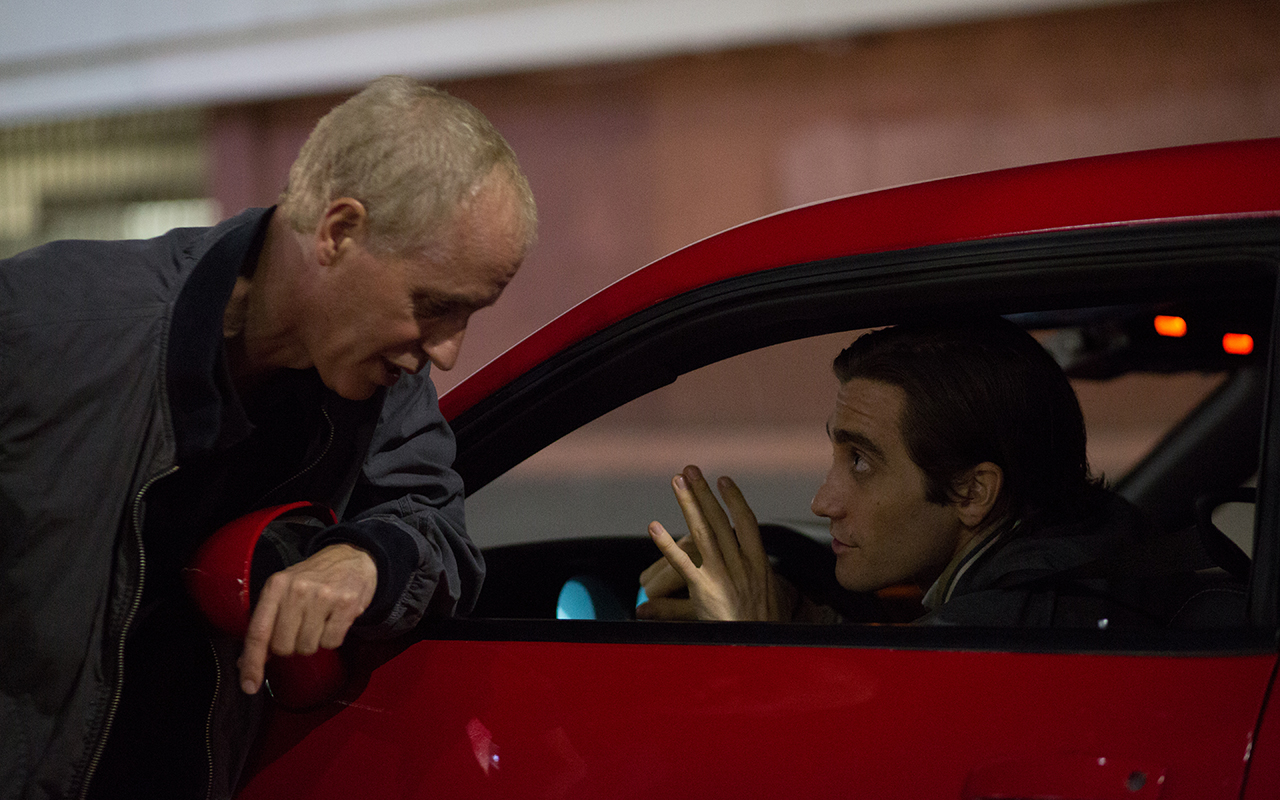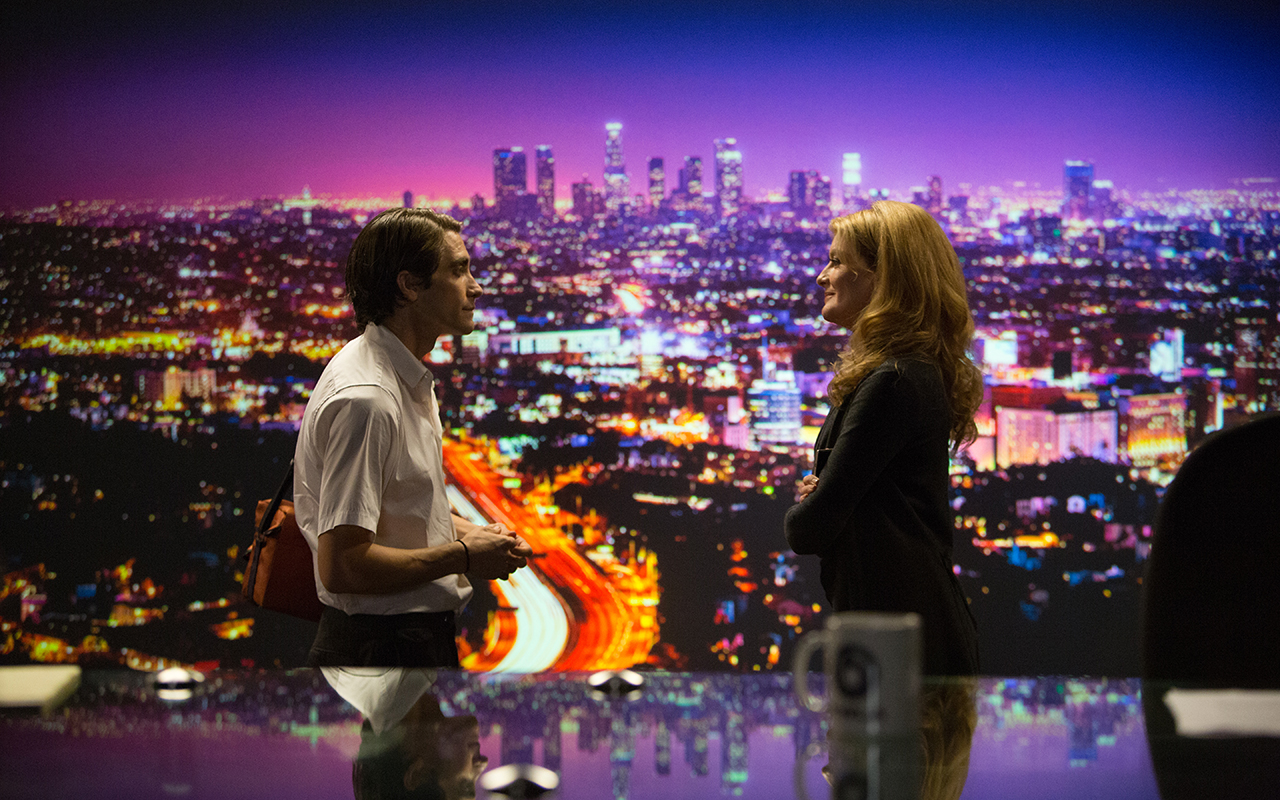Nightcrawler's Dan Gilroy on Turning Jake Gyllenhaal into a Coyote
And interns, the debut director thinks you'll relate.
Nightcrawler glides through the streets of Los Angeles, following the efforts of a young man doing whatever he can to make a living. Trying to survive and thrive, Lou Bloom (Jake Gyllenhaal) warms to a career as a freelance cameraman. He stalks the Los Angeles streets by night to find and film humanity at its worst, all for television news consumption — and maybe gets a little too good at his new profession.
Nightcrawler also brings two familiar creative forces together, but in a new fashion. For writer/director Dan Gilroy, Nightcrawler marks his first helming effort after more than two decades writing screenplays for the likes of The Bourne Legacy, Two for the Money, The Fall, and Real Steel, among others. For star Jake Gyllenhaal, his leading man looks are whittled down to a lean, mean figure of determination and desperation.
Their combination results in what's widely regarded as one of the best films of the year — and certain highlights of both of their careers. We chat to Gilroy about collaborating with Gyllenhaal, creating such a distinctive character, and telling this dark, cynical and twisted tale of modern life.
![]()
How did Jake Gyllenhaal come to be involved in the film as an actor and a producer?
Jake's agent read the script. Jake responded to the script. I flew to Atlanta when he was doing Prisoners. We had a four-hour dinner, and we had just an instant creative spark.
If I was going to distil it down, Jake very much wanted to rehearse and be a collaborator, and I very much wanted to collaborate with Jake. He never changed a word of the script, but what we did do is, we rehearsed for months before we started to shoot. We would discuss the script, the scenes, the character. We would then start to rehearse the scenes themselves, trying them different ways — "what if the character was this? What if the character was that?"
And was Jake's physical transformation part of that?
During the process, Jake came up with a number of very crucial components. One was that it was his idea to lose the weight. He was thinking about a coyote, which you see at night in Los Angeles. They're very hungry and lean looking creatures, and Jake used that as a sort of symbol animal for himself. So it was Jake's idea to lose like 26, 27 pounds, and it utterly transformed him. It was a very bold decision. Very difficult to keep that weight off, and it changed him physically, but it also gave him a tremendous odd energy in the film. I feel like he just wants to consume everything around him — and it's not just food. I feel like he wants to consume ideas and people and anything he can get his hands on. It is a very scary energy that it adds to the character, and to the movie.
It was Jake's idea to put his hair up in a bun any time he does something larcenous. These are the small things. Jake and I worked as creative collaborators on this film in every way.
Let's talk about Lou Bloom. He's such a distinctive character. Where did Lou Bloom as a creation come from?
I have tremendous empathy for tens of millions of young people around the world who are looking for work, and being offered internships and wages that you can't sustain yourself on. So I was very interested in a younger man who was desperate for work. That was the doorway that I came through for the character, which is why at the beginning of the film, he is truly desperate for work. I took that desperation and started to play around with it, and use it as an inner force that has driven this character over the bend in terms of what he was willing to do and not to. And that was pathway to lead me into the character.
Looking at the film more broadly, what inspired the story? There's many components — the media, at face value, as well as questions of ethics and the complicit nature of the audience in consuming news stories, and also the current state of the American economy, trying to chase the American dream...
Well, the story on its largest level, I wanted to do an entertaining, engaging story, so obviously there's suspense and there's uncertainty and there's drama. So all those things I knew were going to be the things that were at the top of my list when crafting the story.
As I started getting into the story, it started to become personal on the level that you just talked about. Which is, I feel that the world I am seeing right now, that I am living in right now in Los Angeles, and I guess the United States, and probably globally in some degree, is one where everything has been reduced to transactions. It seems like the bottom line is driving everything, that capitalism — and I'm not advocating any other system other than capitalism, because I don't know if there is anything better — but capitalism seems to be becoming hyper-capitalism, and it is forcing people to do things in the workplace that I don't think is healthy and I don't think they would normally be inclined to do if they weren't being forced to do it. I saw in Jake's character the opportunity to create an employer who has started a business and very much embodies that principle — that because of the landscape and the lack of work for people, he can pretty much get people to do whatever he wants to each other.
The film is set in Los Angeles, showing a side of LA we don't often see. How did the location shape the film? Could it have been set and made anywhere else?
Well, the location shaped the film in the sense that Robert Elswit, the cinematographer and I, were trying to show the Los Angeles you don't normally see. Los Angeles is usually a very urban environment with cement and buildings. Los Angeles for me is a place with much more of a wild, untamed energy. It is place of mountains, ocean and desert. So we were looking for locations where civilisations met a national park, as in literally. Or we were up on top of a hill looking down, on top of almost a mountain, looking down where you could see forever. We were trying to show a large, sprawling landscape that was physically beautiful — that really was as untouched by man as it tamed by man. And that the character of Lou is like a coyote moving through this nighttime environment of this wilderness.
The sense of tension is unrelenting — not just in the action scenes, with cars racing along the street, but in all of Lou's conversations. How did you maintain that sense of pressure throughout?
The pressure, in many ways, came from the script. The script is designed that way. He is an unsettling character. He is a character who has all these touchstone qualities of humanity — he wants a job, he wants a relationship. He is earnest, he is polite, he is respectful. But at the same time, he is utterly unhinged, and because we shot so close to him, and we would always keep him in frame, and because the score was always going counterpoint, I think the tension is an inner tension of "why am I so emotionally involved in this character?" Or "why are they making me pay attention for this guy? Why am I rooting for him at times when I know I shouldn't be rooting for him?" And I think there's a subconscious energy that starts to build up, a disquieting energy of tension. Questions of "where is it going?" and "why do I like him?", which was as much a design of the script as anything.
Given that Nightcrawler falls into a number of genres, were there films that inspired you in writing and making it?
The films that inspired me more weren't so much journalism films, but films where the hero was also the antihero. Where you could take a character who was your hero and your villain at the same time. One of them was Scorsese's The King of Comedy. And another one is actually Nicole Kidman in To Die For. I loved that film, and I thought she did a great job. I love the idea that she is so perky and personable, and she is a complete murderer. But at the same time, she is your hero — she is your hero and your villain. That was very illuminating when I saw that film. That film was in my mind.
![]()
Nightcrawler opened in cinemas on November 27. Read our full review.








